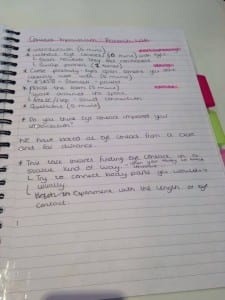This week’s reading, What’s the Score? Structured Improvisation as National Pastime by Maura Keefe, brought up many unanswered questions for me. As I don’t actually know what a score is, trying to connect and understand this reading seemed next to impossible. What did Keefe mean when she talked about ‘a score for structured improvisation’? (Keefe, 2003, 229). As I read on things started to make a little bit more sense to me. I could see the comparisons she made as she talked about baseball being similar to improvisation. ‘The choreography of baseball as structured improvisation’ (Keefe, 2003, 233) got me thinking about how baseball cannot be predicted. Although we know the overall set of what’s going to happen in the game, we never know how the players may choose to portray this. This is very similar to contact improvisation, as dancers know they will contact with someone during a jam. It is just up to them how and for how long they achieve this. ‘Baseball’s structure is understood certainly, but every game is different’ (Keefe, 2003, 234) this is so similar to contact improvisation. We understand the concept of what we should be doing, but there is no way you could draw exact comparisons between two different jams for example. I enjoyed this weeks’ reading as it did kind of help me figure out what a score was, whilst at the same time, drawing upon comparisons in dance and sport that I had never really thought about.
I was excited for this week’s contact research labs, with a clear structure and interesting questions I couldn’t wait to see what we would find out this week. We decided to base this weeks contact lab on dynamics and balance points within the upper kinesphere. Our idea behind this was because we felt like it is the elements we neglect the most, dynamics for me are something that i find next to impossible to change immediately. Our first exercise was to get the class to stand by themselves and then improvise, but only using the upper kinesphere, we then got them to speed up by using the numbers 1-10. I found this exercise very interesting to watch, you could see everyone really concentrating on making their movement faster or slower. This got me to thinking, Why don’t we use a speed technique like this during jams? You could also see the dancers movement range getting slowly smaller as the movement got faster, this was something that was very interesting to me. Why can’t we perform large movements as fast as we can with small ones?
I found from this exercise that by forcing people to change dynamics, they can. However when told to go back to their own speed, most dancers would just return to the speed they feel most comfortable working at. We then told them to try the same exercise again but in pairs, this time as I was leading the exercise, I felt I should add another concept to it. Although they were with a partner I told them to resist with what the other person was doing, something that is rarely experimented with in contact. As they were resisting and changing speed, some different movement styles began to develop. You could see people forced to break their habitual movement patterns as that would mean they had to travel with their partner.
Our third exercise was about finding safe balance points, this is something that I know many dancers struggle with. We didn’t ask the dancers to improvise, just literally think about finding interesting lifts. And the things they came up with were amazing. Whilst still thinking about being in the upper kinesphere, lifts were coming out of nowhere. Every single pair had a different movement and I couldn’t help but be impressed by some pupils sense of balance and awareness while they were on their partner. Why is it so hard to fit lifts into a jam situation? After this exercise was over we asked the couple’s to improvise using all the things they had learnt during the lesson.
I found out from this contact research lab, that when pushed out of your comfort zone you are more likely to achieve different movements than when you play it safe. Dynamics began to be something that people were playing with, and i loved watching the difference in improvisation from the end to the beginning of our slot. When pushed dancers can work in the upper kinesphere and they can make amazing movements, that before you would have never seen.
I am excited to put all these elements I have learnt into my own practice and see if they really can improve an awkward jam situation!
Keefe, M. (2003) What’s the score? Improvisation in Everyday Life. In: Albright, A. C., & Gere, D.Taken by surprise: A dance improvisation reader. Middletown, Conn: Wesleyan University Press, 229-237.
